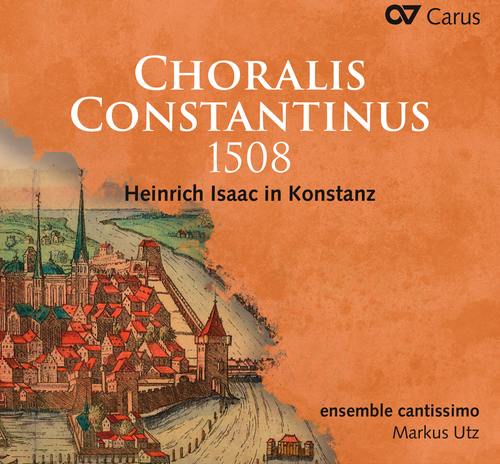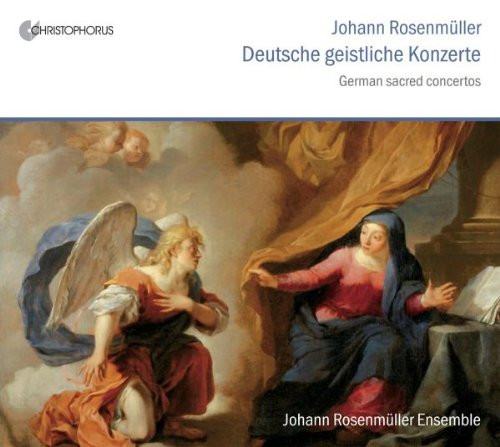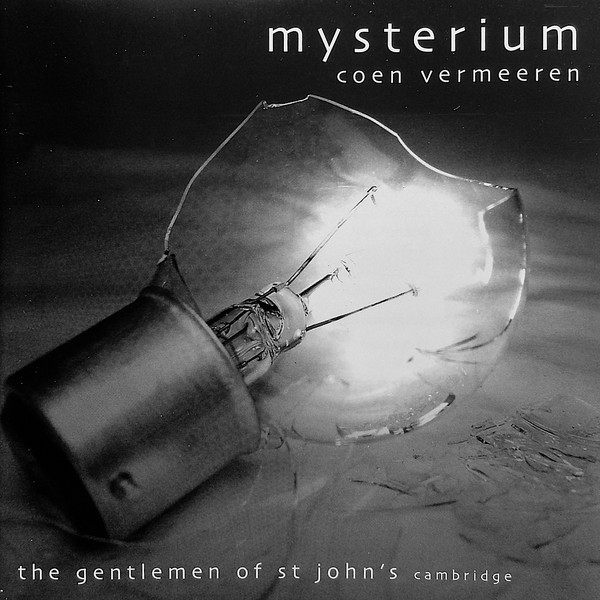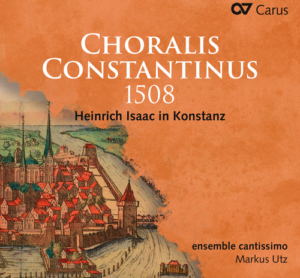Program: #23-49 Air Date: Dec 04, 2023
To listen to this show, you must first LOG IN. If you have already logged in, but you are still seeing this message, please SUBSCRIBE or UPGRADE your subscriber level today.
Two recent releases we have featured earlier this year have extensive seasonal works we've saved for the holidays: world-premiere recordings from Isaac’s Choralis Constantinus, and extensive 13 part motet by Johann Rosenmuller.
I. Choralis Constantinus 1508
(Ensemble Cantissimo directed by Markus Utz) Carus CD # 83.524.

The Choralis Constantinus is one of the most important motet collections of the Renaissance period. Heinrich Isaac wrote it during 1508 to a commission from the chapter of Constance Cathedral. A large number of the total of 375 motets are now largely unknown. ensemble cantissimo has worked intensively on the collection for several years. Under conductor Markus Utz, the singers present a selection of festive motets on this album – an impressive testament to the first musical golden age of the Renaissance. A magnificent rediscovery!
Founded in 1994, ensemble cantissimo is one of the most sought-after vocal ensembles in the German-speaking world. The name says it all: “cantissimo” signifies the focus on vocal music with an emphasis on a cappella singing; at the same time, the ensemble’s main interest has always been “unheard” music outside the usual repertoire. With their characteristic interpretations and exciting choice of programs, the singers from all over Switzerland and Germany, under the direction of the ensemble founder Markus Utz, has delighted critics and audiences alike. The ensemble cantissimo initially established itself with performances at the Heiligkreuzer Konzerte Kempten. These were followed by performances throughout Germany, Austria, Switzerland, Italy and Israel. In 2018, ensemble cantissimo was invited by Yale University as the only European choir to participate in the Yale International Choral Festival 2018 and debuted with great success in concerts in New York and Boston. Regular invitations to renowned concert festivals as well as a close cooperation with broadcasting companies testify to the high esteem in which the ensemble’s vocal art is held.
The by now considerable discography of ensemble cantissimo includes some world premiere recordings and rediscoveries highly praised by the specialist press, for example, the CD recordings dealing with sacred works of the Mozart teacher Giovanni Battista Martini or the Marian cycle “Mater Dei” by the Freiburg composer Franz Philipp, a coproduction with SWR published by Spektral. 2010 saw the release of the coproduc tion with BR “I Himmelen” containing Scandinavian choral music, in 2015 “War Dreams – Songs on War and Peace” with the Raschér Saxophone Quartet and in 2016 sacred works by the Swiss philosopher, politician and composer Adolf Brunner. In 2011–2013 the Carus-Verlag engaged the ensemble for the premiere recordings of the choral works of Brahms contemporary Heinrich von Herzogenberg, which can be heard on three CDs.
From Ear Relevant: The early Renaissance musician Heinrich Isaac (ca. 1445/50-1517) may well be the most important composer whose name is still relatively little known to many 21st-century music lovers. This remarkable new recording, Choralis Constantinus, should go a long way toward bringing the Netherlands-born Isaac’s music to more listeners. The 18 tracks here, superbly sung by ensemble cantissimo with period instruments of the Concerto Dell’Ombra, make a strong case for the beauty and merit of Isaac’s oeuvre. Varying in length from about a minute to seven and a half minutes, the works recorded here (both chant and polyphony) for voice and instruments are worthy representatives of the Choralis Constantinus, a collection of 375 motets in three volumes representing all Sundays and feast days of the liturgical year. This massive work, commissioned by the chapter of Constance Cathedral, was composed in 1508.
Isaac was a legendary figure in his era: in 1485, Lorenzo di Medici invited him to Florence, where Isaac joined such famous creative Florentines as da Vinci, Botticelli, and Michelangelo. Later, Isaac was appointed court composer by the Holy Roman Emperor Maximilian; the Cathedral of Constance commissioned an extensive group of motets celebrating the feasts of the liturgical year. In the ensuing decades, however, the Reformation led to many changes in the liturgical milieu to which Isaac had made such remarkable contributions.
The performances recorded here represent only a fraction of the vast “Choralis Constantinus,” with selections representing four subject areas: “Weihnachten” (Christmas), “Maria” (the Virgin Mary), “Ostern/Himmelfart/Pfingsten” (Easter, Ascension, Pentecost), and “Konradifest” (Feast of St. Conrad). The majority (13) of the 18 tracks are world premiere recordings.
And they are splendid.
Director Markus Utz draws beautiful, nimble, clear singing from the dozen men and women of his ensemble cantissimo (three singers in each category: sopranos, altos, tenors, basses). The singers, drawn from Switzerland and Germany, are agile, accurate, and lovely to hear; not for them the often-bloodless sounds of “correct” period ensembles, but clear and beautifully characterized vocal lines that make the music arresting and individualized. Utz, a conductor/organist based at Zurich University of the Arts and a regular visiting faculty member at Yale University, founded the ensemble cantissimo in 1994 and is in regular demand as teacher/conductor from Hong Kong to Israel.
The singers are featured with four instrumentalists of the Concerto Dell’Ombra: a tenor and a bass trombone, and a soprano and a tenor recorder. The instruments provide enhancement and richer timbres to the vocal lines in some particularly beautiful ways. On Track 10 (“Resurrexi Domini”), for example, the brass instruments overlay the statements from men’s voices for an effect of high seriousness; the clarity of the women’s lines in rising melodic statements is remarkable. The singers are underscored but never overwhelmed by the winds’ accompaniment. We hear not just a wash of choral sound but an ensemble in which voices are recognizable and differently inflected, with occasional subtle use of vibrato. The effect is one of high seriousness but also of stirring beauty.
Track 8 (“Ave Maria”) opens with two male voices interweaving in and out in an inventive preamble; gradually, more voices and instruments are added as the piece grows in complexity. Lines are shaped and inflected, sung lyrically or declaimed; otherworldly lines without vibrato morph into other forms, and then in comes the cornetto. Layer upon layer is added, and the full ensemble finally draws to an apparent close – but no, male voices arise again, and the rest of the group enters for a finale.
The vocal and instrumental textures throughout the recording are consistently intriguing, and the singing is cleanly beautiful. The men’s and women’s voices rise in what is not just an anonymous wash of choral sound; the voices are recognizable and differently inflected, and some vibrato is employed as an occasional expressive device. And yet the overall feeling of unanimity is preserved.
For those who love Renaissance vocal and instrumental music, this introduction to the Choralis Constantinus will be a most welcome discovery.
Heinrich ISAAC: Puer natus est nobis
Heinrich ISAAC: Natus ante saecula
Heinrich ISAAC: Viderunt omnes
Heinrich ISAAC: Vidimus Stellam
Heinrich ISAAC: Responsum accepit Simeon
Heinrich ISAAC: Rorate Coeli
Heinrich ISAAC: Ave Maria
Heinrich ISAAC: Magnificat
Heinrich ISAAC: Resurrexi Domini
Heinrich ISAAC: Haec Dies
Heinrich ISAAC: Pascha Nostrum
Heinrich ISAAC: Viri Galilei
Heinrich ISAAC: Dominus in Sina
Heinrich ISAAC: Spiritus Domini
Heinrich ISAAC: Veni sancte Spiritus
Heinrich ISAAC: Sacerdotes tui Domini
Heinrich ISAAC: Ecce sacerdos
II. Johann Rosemüller: German Sacred Concertos
(Johann Rosenmüller Ensemble/Arno Paduch). Christophorus CD CHE 0221-2.

From MusicWeb International: Many German composers of the 17th century were strongly influenced by the Italian style. One of the most prominent was Johann Rosenmüller. A large part of his career he spent in Italy, but even before that he was writing in a dramatic style which showed his preference for Italian music.
Rosenmüller matriculated in the theological faculty of Leipzig University in 1640 and very likely became a pupil of Tobias Michael, who was Thomaskantor at the time. Rosenmüller was the most likely successor of Michael, but his career came to an abrupt end when he was arrested for paedophilia. He fled to Italy, where he became trombonist of the San Marco. He also acted as composer of the Ospedale della Pietà from 1678 to 1682. His ties with Germany remained intact: several German musicians studied with him, and he sent some of his compositions to his native country. Towards the end of his life he returned to Germany, where he held the position of Kapellmeister at the court of Wolffenbüttel.
A book from 1728 tells us about Rosenmüller's old age: "I spoke to this Rosenmüller after he had left Italy and returned to Wolffenbüttel, where he was working as Kapellmeister, and still found him to be a hot-tempered and, because of his age, morose man whom nobody could please and who was forever sorely at odds with his assistants".
The very fact that he was specifically mentioned in a book from 1728 - more than 40 year after his death - is an indication that his music was still known. That is confirmed by Telemann's autobiography of 1740 who states that Rosenmüller belonged to the composers who had inspired him in his sacred and instrumental music. Rosenmüller's works were widespread in Germany, but most of them were never printed. Because of that it is mostly impossible to put a date on them. Of his sacred music only the two volumes of the Kern-Sprüche were published, before his escape to Italy.
The two pieces which open and close the programme on this disc are from the first volume, which appeared in 1648. They are examples of the concertante style which was modelled by Heinrich Schütz. These are pieces for voices and instruments, in which rhythmic contrasts are used to discern the various episodes. In Daran ist erschienen die Liebe Gottes Rosenmüller also juxtaposes various voices and voice groups to create a contrast between phrases, like "not that we loved God" versus "but that he loved us".
The two most Italianate pieces are the dialogues which are reminiscent of the oratorios of, for instance, Carissimi. Vater, ich habe gesündiget is a setting of the parable of the prodigal son (Luke 15), in which the various roles are given to an alto, two tenors and a bass. In most of the piece the voices are supported by the basso continuo alone, but when the father says "Let us feast and be merry", the strings enter in a vivid rhythm, illustrating the joy that greets the son's return. The dialogue ends with a conclusion for the four voices and the instruments: "Likewise joy shall be in heaven over one sinner who repents".
Another parable is set in Was stehet ihr hie. This time it is about the labourers in the vineyard (Matthew 20). Rosenmüller has omitted several verses, and in order to point out the gap in time he includes an instrumental interlude. The owner of the vineyard is sung by a bass, the labourers by the other voices. There are two striking examples of text illustration. When the vinedresser says: "Steward, call the labourers and give them their hire, beginning from the last unto the first", the last part is set to a rising figure. The labourers who have come last get the same as those who came first, and the latter complain: "Thou hast made them equal to us, who have borne the burden and heat of the day". This is illustrated by a slow descending figure depicting their hard labour. The piece again ends with the tutti on the words: "So the last shall be first and the first last".
Entsetze dich Natur is an unusually long work on a text by Rosenmüller's friend Caspar Ziegler. It begins with the words: "Be shaken, Nature, thou must change, for God himself is made a man, the Creator come to earth". It is known that this sacred concerto was first performed on Christmas Day in 1649. It is a strophic piece in which the stanzas are interspersed with ritornellos.
Ach Herr, strafe mich nicht is a setting of Psalm 6, for soprano and instruments. It contains plenty of text illustration, like pauses after "schwach" (weak) or "erschrocken" ([my bones are] vexed). Words like "seufzen" (sigh) and "Tränen" (tears) get a special treatment in that the first syllables are interrupted by short pauses, as if the singer is breathless with emotion. In these phrases the voice is echoed by the violin. Here again the various contrasting episodes are marked by instrumental passages.
O Jesu süß, wer dein gedenket is a setting of the first verses from a German version of a hymn by Bernard of Clairvaux. It is scored for tenor, two violins and bc. Although the vocal part contains some ornamentation it is especially the violins which are given elaborate and virtuosic parts.
Ich weiß, daß mein Erlöser lebt is written on the well-known text from Job: "I know that my Redeemer liveth". It is set for bass with instruments and bc, and contains some eloquent coloratura. At the end the opening words return. The programme is completed with an instrumental sonata which is not much different from the vocal pieces. Two allegros embrace an adagio which has the character of a recitative.
The performances are generally pretty good, in particular the larger-scale pieces. Here the splendour of Rosenmüller's compositions comes off really well. But the performances of the dialogues and the solo pieces show some flaws. The booklet doesn't tell who is singing which piece, but I am pretty sure that Ach Herr, strafe mich nicht is sung by Irena Troupova. She gives an expressive performance, but I regret the slight tremolo in her voice. Her German pronunciation is also not perfect. Most disappointing is the bass Martin Backhaus, whose voice lacks presence, and almost sounds a bit amateurish. In particular some passages in Was stehet ihr hie are unsatisfying. In Vater, ich habe gesündiget his part seems too high for his voice. Ich weiß, daß mein Erlöser lebt is sung well, though. The alto and the two tenors are really good: they have beautiful voices and their singing is crisp and clear. The tenor who sings O Jesu süß delivers a really fine performance. The instrumentalists are without exception excellent.
The booklet is disappointing. The programme notes are rather short, and the German lyrics (which are also translated into English) contain a number of errors. This must be the oldest recording ever made, by the way: the booklet gives November of the year 1000 as the recording date ...
Johan van Veen
Siehe an die Werke Gottes a 15 [05:39]
Ach Herr, strafe mich nicht a 5 [09:17]
Vater, ich habe gesündiget a 6 [07:51]
Sonata a 2 per Violino e Fagotto (1682) [05:15]
O Jesu süß, wer dein gedenket a 3 [06:03]
Entsetze dich Natur a 13 [19:22]
Was stehet ihr hie a 10 [07:17]
Ich weiß, daß mein Erlöser lebt a 6 [05:07]
Daran ist erschienen die Liebe Gottes a 7 [06:16]
III. Mysterium
(The Gentlemen of St. John’s College, Cambridge). VMP CD 0201

| 1 | O Magnum Mysterium | 3:22 | |
| Fourteen Introits For Advent And Christmas | |||
| 2 | Ad Te Levavi Animam Meam | 4:39 | |
| 3 | Populus Sion | 4:51 | |
| 4 | Gaudete In Domino | 5:47 | |
| 5 | Rorate Caeli | 4:06 | |
| 6 | Hodie Scietis | 3:59 | |
| 7 | Dominus Dixit Ad Me | 2:33 | |
| 8 | Lux Fulgebit | 4:16 | |
| Mysterium Nativitatis Domini | |||
| 9 | Prima Pars | 6:59 | |
| 10 | Ave Maria | 2:34 | |
| 11 | Secunda Pars | 6:58 | |
| Fourteen Introits For Advent And Christmas | |||
| 12 | Puer Natus Est Nobis | 4:29 | |
| 13 | Deus In Loco Sancto Suo | 4:38 | |
| 14 | Salva Sancta Parens | 3:11 | |
| 15 | Dum Medium Silentium | 5:14 | |
| 16 | Ecce Advenit Dominator Dominus | 3:24 | |
| 17 | Dilexisti Iustitiam | 4:43 | |
| 18 | Ex Ore Infantium |
Composer Info
Heinrich ISAAC, Johann Rosemüller
CD Info
Carus CD # 83.524, Christophorus CD CHE 0221-2, VMP CD 0201
